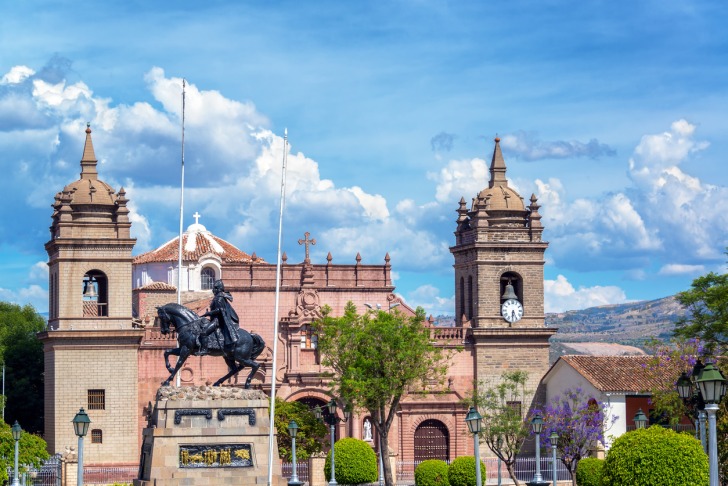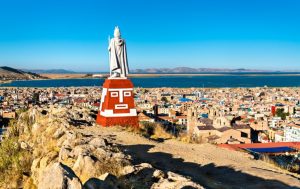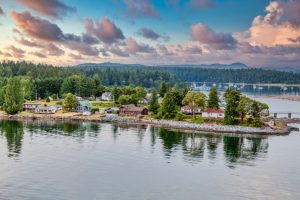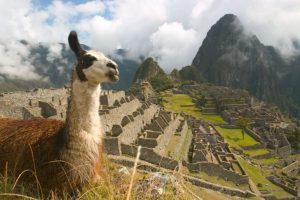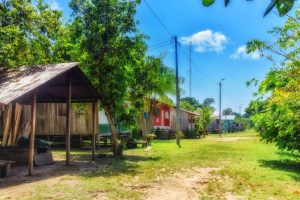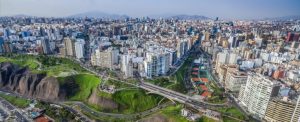You won’t find Ayacucho, Peru in many itineraries.
While Peru has grown in popularity in recent years, there are a few reasons why Ayacucho has lagged behind.
One of the biggest reasons is its rocky and violent past.
However, today Ayacucho offers a quaint city that still maintains its traditional culture side by side with modern amenities.
Before you begin planning your trip, it’s important to know whether Ayacucho is a safe place to visit, or should be avoided.
Warnings & Dangers in Ayacucho

OVERALL RISK: MEDIUM
Determining the safety of Ayacucho is initially confusing. Several governments, including the U.S. and Australia, say that you should avoid traveling to Ayacucho. However, a closer look reveals many travelers who say that it's a great place to visit. The discrepancy seems to come from the fact that Ayacucho is a city and a region. The region includes remote mountain areas that are well known for drug manufacturing and trafficking and should be avoided at all costs. However, the city of Ayacucho itself is no more dangerous than your average city. Yes, there are dangers in the city, including crime. However, the area isn't as dangerous as you may think at first glance.

TRANSPORT & TAXIS RISK: HIGH
Buses are relatively safe in Ayachucho, although you should keep an eye out for pickpockets and avoid placing your bags in an overhead compartment. However, taxis can be dangerous. Licensed taxis are perfectly safe. However, unlicensed taxis are not. There are reports of people being robbed or assaulted when in these taxis. To ensure you are safe, only use a licensed taxi. You can find them by calling the taxi company, or have the hotel or airport call one for you. Do not attempt to hail a taxi on the street.

PICKPOCKETS RISK: MEDIUM
Pickpocketing is pretty common in Peru. However, it's a bit less common in Ayacucho because there are few tourists. Pickpockets often work in teams or pairs. This means one person will distract you, while someone else steals your things.

NATURAL DISASTERS RISK: HIGH
Ayacucho does experience natural disasters. It's in a volcanic region. Volcanic eruptions, heavy rains, and flooding. It's also susceptible to landslides, due to the rainfall, soil, land cover, and earthquakes.

MUGGING RISK: MEDIUM
Mugging and other violent crimes do occur in Ayacucho. You should take some precautions to stay safe while traveling here, including traveling with others. Several governments, including the U.S. and Australia, recommend that you exercise caution when traveling to Peru. As mentioned previously, Ayacucho is considered a higher-risk area. However, the city itself is not more dangerous than other areas of Peru.

TERRORISM RISK: HIGH
The risk of terrorism and civil unrest is higher in Peru than in most countries. Terrorism is uncommon, but still occurs. It used to be a major concern in Ayacucho, due to the terrorist group the Path of the Shining Light. This group is no longer active in the area. However, civil unrest is a concern. According to the U.S. Department of State, you should be cautious when traveling in Ayacucho due to potential civil unrest.

SCAMS RISK: MEDIUM
There is a risk of scams in Peru, including Ayacucho. Be cautious when using a bank or credit card. Be on the lookout for issues with card readers. Other scams include counterfeit taxis and telephone scams. You may also encounter people who promise to do work for you for a deposit, and then disappear. This is unlikely to happen if you are on vacation, however.

WOMEN TRAVELERS RISK: MEDIUM
Women travelers should be cautious in Ayacucho. Crimes, including assaults and robberies, do happen here. However, the city is not more dangerous than an average city for women, as long as you avoid the remote regions outside the city. The locals are generally very friendly and charming.

TAP WATER RISK: HIGH
The tap water is generally not safe in Ayacucho. You should drink bottled or boiled water. If you are staying in a hotel, you can ask if the water is safe. However, microbes that locals are used to can cause upset stomach for you, because your body isn't accustomed to them, so it's best to avoid drinking the tap water completely. You should also avoid drinks with ice, because the ice may be made with contaminated water. In addition, any foods you eat should be peeled or cooked to avoid contamination. If food is rinsed in contaminated water, this can make you sick as well.
Safest Places to Visit in Ayacucho
There are lots of places you should visit while in Ayacucho.
You can’t miss the historic center, in the center of the city.
It’s known as the city of churches, and for good reason.
San Cristóbal is the oldest church in the region.
You should also visit the Wari ruins.
It was home to a pre-Incan civilization.
Places to Avoid in Ayacucho
There are no areas in the city itself that you should avoid.
However, you should avoid the outskirts of the city, particularly the VRAEM region and the remote mountain areas.
If you are unsure if an area should be avoided, the best way to know is to ask the locals.
They will let you know if the area should be avoided.
Safety Tips for Traveling to Ayacucho
- Travel as Part of a Group. There’s safety in numbers. When traveling, it’s always safer to be part of a group, rather than alone. This is particularly important at night. If you are alone, be sure that you stick to well-lit and populated areas.
- Keep Personal Belongings Close. Ayacucho does have pickpocketing and petty theft, so you should keep your personal belongings safe. Be sure to place your bag between your feet, instead of beside you. Never use the overhead compartments on buses.
- Take Preventative Health Measures. There are several mosquito-borne diseases in Peru. You should speak to your doctor about malaria prevention. You should consider vaccination for yellow fever as well. Wear long sleeved shirts and pants, and use insect repellant when you are out.
- Be Cautious with Food and Drink. Ayacucho doesn’t have a big problem with assault, but you should still avoid leaving your food or drink. Drugs can be slipped into them, incapacitating you. Then, you are at the mercy of the person who drugged you. You should also make sure that any food you eat has been properly cooked. Vegetables and fruits should be cooked or peeled. Remember, the water in Peru can be contaminated. If food is washed in contaminated water, it can make you sick.
- Prepare for Altitude Sickness. Altitude sickness can cause shortness of breath, dizziness, nausea, and feeling generally unwell. Ayacucho is 2,700 meters, or 8,860 feet, above sea level. Altitude sickness can occur at heights of 8,000 feet or higher. Sensitive individuals may feel symptoms at lower elevations, from 5,000 to 7,000 feet. You can get a prescription for altitude sickness medication from your doctor. Medication is available in Ayacucho at drug stores as well. Coca leaves are a traditional and effective remedy which is readily available in the city.
- Stay Vigilant. You’ll want to enjoy yourself when in Ayacucho. However, don’t get so caught up in the sights that you forget to keep an eye on your surroundings. You should also avoid getting intoxicated when out in Ayacucho because it interferes with your ability to observe what’s going on around you. Simply being vigilant is one of the best ways to stay safe. It also makes you look less like a wide-eyed tourist.
- Follow Local Laws and Customs. It’s very important that you show respect in Ayacucho, particularly if you visit a sacred or significant place. It’s against the law to behave poorly in these areas, and foreigners have been detained for doing so. Drug penalties are very stiff, and the government will sometimes use someone as an example. Remember, ignorance of the laws or customs isn’t a good excuse for breaking them.
- Enroll in STEP. STEP stands for Smart Traveller Enrollment Program. It’s a free service that connects you to the nearest U.S. Embassy. You’ll receive alerts about weather and security. It also makes it easier to find you or contact you in an emergency.
- Don’t Display Valuables. When you are traveling, you should leave any valuable items that you don’t need at home. You should be cautious with your phone or camera as well, because they may get stolen. The locals are generally very friendly and helpful, but there is a lot of poverty. Petty theft often occurs because people need money for basic things, and a phone can buy several meals. Valuable items can also make you a target for more serious crimes like mugging. If you clearly have things worth stealing, you are making yourself a target for thieves. It’s best to avoid even the appearance of valuable items, like costume jewelry.
- Don’t Use an Unlicensed Taxi. We’ve already discussed this, but it bears repeating. Avoid using unlicensed taxis. Find a licensed taxi, take a bus, or walk to where you are going.
So... How Safe Is Ayacucho Really?
Ayacucho may have a bad reputation, but it’s most undeserved.
The city is as safe as most other cities you may enter, including those in the U.S.
As long as you take proper precautions and avoid areas outside the city, you can enjoy your trip safely.
How Does Ayacucho Compare?
| City | Safety Index |
|---|---|
| Ayacucho | 44 |
| Puno | 45 |
| Lima | 53 |
| Iquitos | 71 |
| Arequipa | 32 |
| Cusco | 52 |
| Deadwood (United States) | 80 |
| Sturgis (United States) | 80 |
| Pierre (United States) | 81 |
| Spearfish (United States) | 80 |
| Hill City (United States) | 83 |
| Temuco (Chile) | 31 |
Useful Information

Visas
You won't need a visa if you plan to spend less than 183 days in Peru. However, you will need a passport that is valid for the duration of your stay, or 6 months. When you arrive in Peru, they will give your passport a tourist stamp.

Currency
The Peruvian currency is the Sol. You can find exchange offices throughout Ayacucho. You can also exchange American dollars for Sol at local banks. Most ATMs will give you dollars or Sol. Businesses in the city often accept dollars and Sol. Most businesses will also accept major credit cards, including Visa and American Express. However, you should have some Sol on hand in case you can't pay any other way.

Weather
Ayacucho has a subtropical semi-arid climate. The rainy season is from December through March. The dry season is from June through August. Temperatures are fairly stable throughout the year, with highs and lows varying less than 10 degrees throughout the year. The coldest month is July, with an average high of 73°F and a low of 44°F. November is the warmest month, with highs up to 79°F, and a low of 51°F.

Airports
When flying into Peru, you'll likely arrive at the Jorge Chávez International Airport in Lima. From here, you can fly to Coronel FAP Alfredo Mendívil Duarte Airport.

Travel Insurance
Travel insurance isn't required to enter Peru. However, it is a wise investment. Your American health insurance policy is unlikely to cover any medical expenses you may encounter abroad, and Peru requires you to pay for services when leaving the medical facility. In addition to health insurance, you can choose a policy that covers common travel hazards, including lost luggage and delayed flights.
Ayacucho Weather Averages (Temperatures)
Average High/Low Temperature
| Temperature / Month | Jan | Feb | Mar | Apr | May | Jun | Jul | Aug | Sep | Oct | Nov | Dec |
|---|---|---|---|---|---|---|---|---|---|---|---|---|
| High °C |
26 | 26 | 26 | 27 | 27 | 27 | 26 | 27 | 28 | 28 | 29 | 27 |
| Low °C |
10 | 10 | 10 | 10 | 9 | 7 | 7 | 8 | 9 | 10 | 11 | 11 |
| High °F |
79 | 79 | 79 | 81 | 81 | 81 | 79 | 81 | 82 | 82 | 84 | 81 |
| Low °F |
50 | 50 | 50 | 50 | 48 | 45 | 45 | 46 | 48 | 50 | 52 | 52 |
Peru - Safety by City
| City | Safety Index |
|---|---|
| Arequipa | 32 |
| Ayacucho | 44 |
| Cusco | 52 |
| Iquitos | 71 |
| Lima | 53 |
| Puno | 45 |
